IN THIS LOVELY TIME OF SUMMER: Lars Wivallius and the disappearence of the bees
When I during this short, bleak and cold spring have taken the bike to my work at school, struggling in a bitter head-wind, I have occasionally come to think about Lars Wivallius and his magnificent poem Lament over this Dry and Cold Spring:
A dry and cold spring speeds summer´s demise,
and halts the autumn sprouts.
God help us; see spring how it flies,
leaving sorrow and draughts.
Sun warm us, bring us delights!
Winter carries worries and doubts
Summer brings peaceful nights.

The origin of the poem, of which the above is the first stanza in my own somewhat crappy translation, is to be found close to my home town. In 1629, after steeling, mooching, and cheating his way throughout war-torn Europe the twenty-four-year-old Lars Wivallius turned up at the estate of Hessleholm. According to a German statement, the young poet had been a frequent guest to German prisons, Wivallius was of "a dignified and beautiful appearance" and "when it came to his ability to speak, he did not lack any capacity." Wivallius spoke Latin and German fluently, it appears as if he also mastered English, French, Italian and Greek quite good. While staying at the Hessleholm manor, Wivallius used one of his fake aliases - Baron Erik Gylllenstierna, a way of presenting himself that Wivallius at court later claimed was not entirely incorrect. According to himself he had actually through the use of the name Erik stated that "I am not Gyllenstierna", this since the name “Erik” in Swedish may be pronounced as “är ick”, which means “am not”.
This was a typical Wivallian approach to any issue. He loved to twist words around and had a natural talent for rhetoric. Wherever he showed up, it seemed as if Lars Wivallius through his urbane manners, singing, stories, impressive knowledge and not least a favorable appearance and great charm was able to seduce any company, anywhere. There were few who could suspect that the Swedish nobleman was in fact a poor farmer's educated son. This was also the case at the Hessleholm estate, where the local nobility became enthralled by the handsome young man, who also could "dance, jump height and fence".
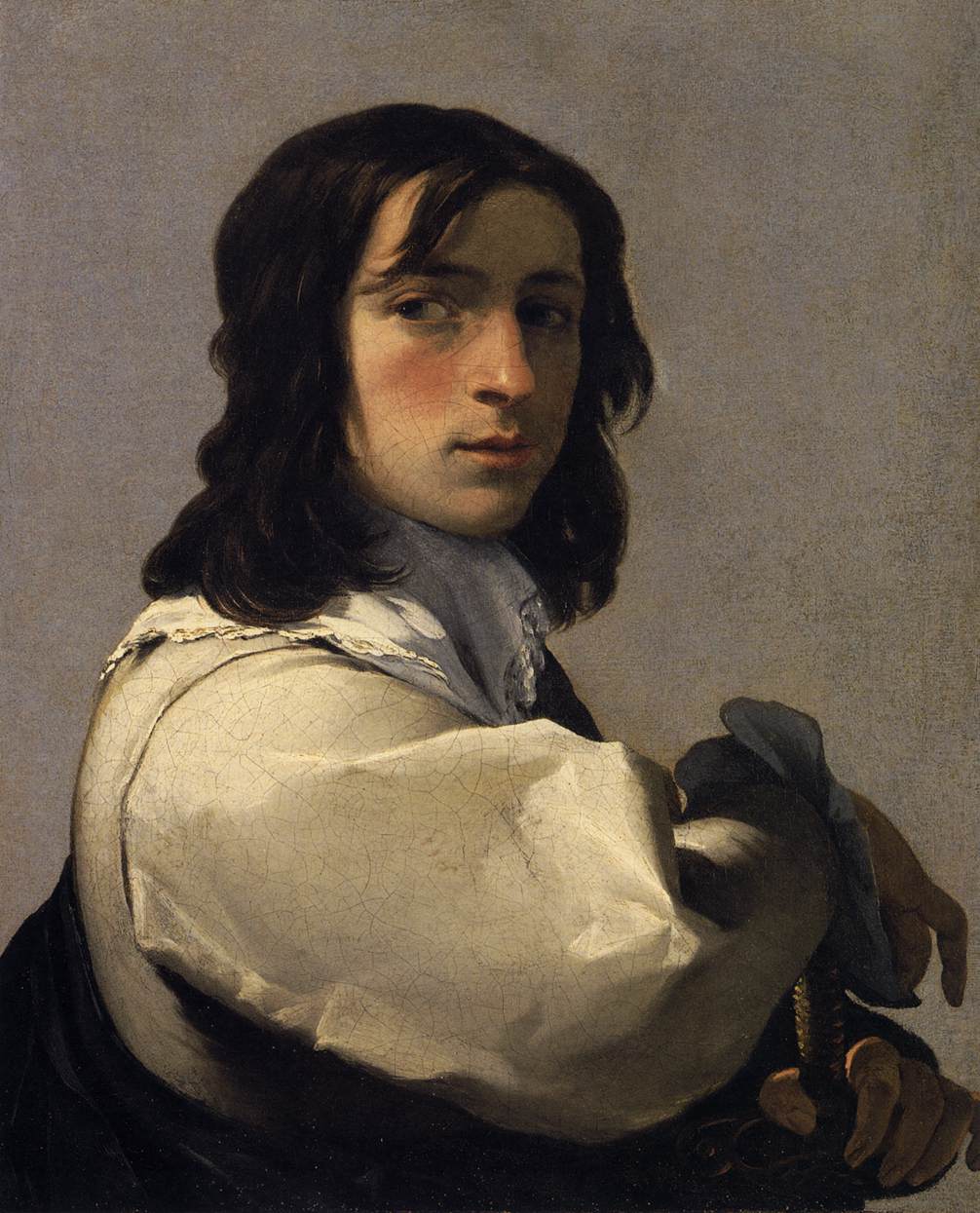
Soon, Lars Wivallius had become betrothed to the beautiful daughter of the wealthy nobleman Ulf Grip, lord of Björkeberga, a few miles to the north of Hessleholm. To forestall a marriage proposal from a wealthy Danish noble suitor, Wivallius married Gertrude Grip in secret. However, the father of the bride immediately forgave the young couple in the belief that it was a better union. Unfortunately, while invited to a vicar in Hallaryd, on the other side of the border to Sweden, the fake Baron Gyllenstierna was recognized by the vicar´s curate:
- My lord, you are eerily akin to a person I knew while I studied in Uppsala. His name was Wivallius and they say he now serves as a colonel with the Emperor. Have you known him while being abroad?
This was a dangerously tight spot. Wivallius responded nimbly:
- For sure, I have met the man and you are right, we do resemble each other, though he has now a big beard, and was sliced over the cheekbone in Paris.
Wivallius was deeply shaken by this evil-boding coincidence and had immediately detected a doubtful glint in the curate´s eyes and knew he now had ended up on thin ice. Not only did the priest's question indicate that he suspected that Baron Erik Gyllenstierna moved around under false colors. His suggestion that Wivallius was in the service of the Emperor could also be interpreted as a serious warning.
While In Danzig, where the Swedish army in 1629 was involved in heavy fighting with Catholic forces, had Wivallius been associating with Jesuits and had even converted to Catholicism. Since Sweden in the name of Lutheranism waged a bloody war against the Catholic Holy Roman Emperor, Ferdinand II, Wivallius´ conversion to Catholicism could be interpreted a treason and he could come under suspicion of being an agent in the service of the papacy.
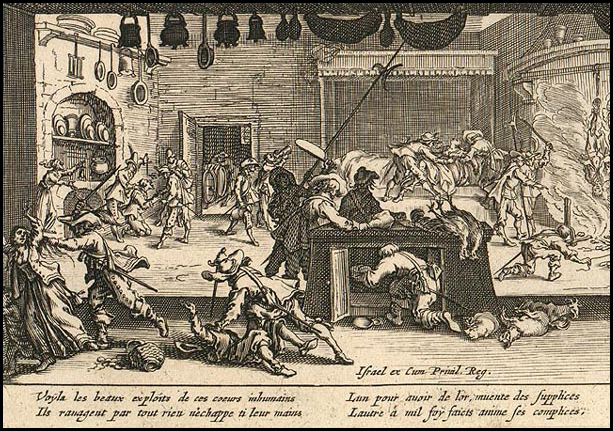
Wivallius knew that his wealthy father worried about an upcoming war between Denmark and Sweden. The district of Scania was at the time Danish and Wivallius offered to bring his wife and sixteen chests filled with valuable goods, as well as two hundred silver coins, for safe storage at his (nonexistent) castle in Sweden. The gullible Ulf Grip gave his son-in-law what he coveted and on his way up to Stockholm Wivallius succeeded in getting rid of his wife as well as selling the content of the chests, making a nice profit.
When his daughter returned abandoned and empty-handed, Ulf Grip quite naturally became beside himself with rage. He had the marriage annulled and the priest who had wedded his daughter to the Swedish rascal suspended. Grip also managed to persuade his friend the Danish king, to issue a warrant for Wivallius both in Denmark and Sweden. Meanwhile Wivallius succeeded, through his poems and propaganda writings, in making himself interesting to the Swedish authorities and applied for a position within the Royal Administration of Pomerania. When the expected appointment dragged on Wivallius decided to travel to Germany anyway. When he on his way down south passed Hessleholm, he succumbed to the insane whim to once again try to pull the wool over the eyes of his gullible ex-father-in-law. Wivallius was as usual in great need of money and had concocted a fantastic story indicating that it was he, Baron Erik Gyllenstierna, who had been deceived and that he was completely innocent of all the mischief he was being accused of having committed.
However, this time Ulf Grip refused to be hoodwinked by his sweet-talking, former son-in-law. He had Wivallius put behind bars in the fortress of the provincial capital, Kristianstad. After he had pleaded his case with Christian IV of Denmark, convincing him that the Swedish swindler was dangerous and had to be prevented from doing more harm, Wivallius was sentenced to death by beheading. However, by tricking a prison guard to make him a copy of the key to his cell Wivallius managed to escape and eventually turned up in Stockholm again. However, he was immediately arrested and thrown into one of the prison cells of the Royal Castle.

True to his wit and boldness Wivallius was soon out of prison and managed through his poetry and flattery to acquire the support of influential patrons and also succeeded, in a masterly way, to use his sharp rhetoric to defend himself before the courts and the Swedish National Council. Nevertheless, the wealthy Ulf Grip had secured support even in Stockholm and several people in authority soon lost patience with the adroit contortionist Wivallius, and he went back and forth in custody of the prison of Royal Castle. At one point he disappeared during ongoing court proceedings and a warrant had to be issued for his instantaneous detention and distributed all over the Kingdom, before he once again was arrested in Stockholm and finally sentenced to imprisonment for an unspecified time.
Perhaps it was his audacious personality that turned out to be a disadvantage for Wivallius. He was a poor farmer's son who had learned both Latin and Greek at the University of Uppsala and on top of that h had acquired foreign and polished manners which he used to impress and gain benefits from Swedish nobility and officials. This was maybe Wivallius´ greatest crime – a commoner who had had the audacity to commit petty crimes and shams in the guise as a Swedish nobleman. As the Swedish expression has it – “a cat had entered among the ermines”. Why would Wivallius otherwise have been punished so severely for crimes committed in Göinge, a place that Swedish troops had ravaged and plundered ten years earlier and in a country like Denmark, which ten years later would fight a bloody war with Sweden? The authorities were perhaps worried by a person whose only power and weapons was words and had shown no inhibitions when it came to using them. Wivallius´ poems and pamphlets were printed and distributed all over Stockholm and if he appeared in court people flocked to listen to his defense and when he happened to be on the loose from prison he found an enthusiastic audience in the taverns of Stockholm.

He was shackled and sent to Kajaani Castle, far away in the depths of the Finnish forests. In a farewell poem Wivallius lamented his sad fate: "God, please console my soul now when I am chained and sent to the northernmost mountains." The gloomy fortress of Kajanus was situated on an islet in the middle of the rapids of the Kajana River. It was the Swedish Kingdom´s farthest outpost against the mighty Russian Empire. When Wivallius was brought to the gloomy fortress, twenty-four soldiers and four prison guards were stationed there. He spent more than seven years enclosed by a cell with a bed, a desk, a latrine and a wood fuelled stove on which he cooked his food. It was here he wrote his Lament over this Dry and Cold Spring, which is a fervent tribute to the Swedish summer. A long prayer to God that he would protect and preserve all the wonderful things found in the summer fair Swedish nature:
Let the forest stand green, bring fruits to the trees.
Let no need pester us,
quicken the breeze to bring freshness and ease,
Bless the forests, the fields and the meadows!
Bring garlands and delight. Let worries cease.
Make flowerbeds in peaceful shadows.
We read the long poem in school and at the same time the troubadour Evert Taube wrote his popular tune Änglamark, Angel´s Earth, which could be characterized as was a modern version of Wivallius´ celebration of the Swedish summer:
Let children dance like angels around maple and elm,
playing where flowers gardens overwhelm.
Let the birds live and sing their chants,
Let fish swim amid rocks and water plants.
Stop the rule of the hunter´s gun!
Let the eagle fly, let the deer run!
Let the last river roar and shine,
still thundering amid spruce and pine.
After last year´s graduation ceremony I took the bike to our house in Bjärnum. On my way through the woods, I hummed the summer hymn that is sung in school before the kids run out in to the sun:
Time for blossoming is here,
with joy and beauty everywhere.
Sweet summer is arriving
when grass and crops are thriving .
Gentle warmth is spread
to all that have been dead.
Touched by beams of sun
the power of death´s undone
After enjoying a cup of coffee amidst the lush greenery, I rowed the boat to the middle of the serene lake, where I rested on the oars, breathing deeply while looking around at the beauty that surrounded me. Without a ripple the water´s surface reflected drifting, light summer clouds, while the shores flaunted their green abundance. Back in the house I read Wivallius´ poem and found the stanza:
Let bees crowd round bowers and flowers,
extracting their honey in summer´s sweet hours.

I realized something was missing. Outside the house our large rhododendron bushes bloomed and before that the bird cherry and lilacs had blossomed, while the apple trees had carried more flowers than usual. The sounds of early summer were all around me. After I had been given an audio book with bird sounds I was more familiar with their singing than before. High above them all the Black Bird´s performed his joyous arias, more heartbreaking and grandiose than the Mavis´ imprudent, almost drunken singing. From the thicket could be heard how the Willow Warbler sang his melodies tuned in a minor key, interspersed with the Robin´s cutting, high, squeaky sound and the Great Tit´s sharp, tri-syllabic song, bringing with it a whiff of late winter air. Around rhododendrons and apple tree flowers there was however a deep silence. Where had all the bees gone? Were they all dead?
There is currently an ongoing mass death of bees, the like of which has never been seen before. Desperate beekeepers find their hives filled with larvae, but almost empty of adult bees and the few which stagger among the corpses of their sisters seem to have lost their appetite. The phenomenon is known as Colony Collapse Disorder (CCD). It is not a disease but rather a syndrome caused by a variety of factors. The obvious reason for the disaster is a parasite, a mite called vaora, which subsists on the blood fluid of bees. Through a virus carried by the mite, bees lose their sense of orientation, becoming confused within the hive and getting lost outside of it, many are furthermore suffering severe malformations, while others lose their appetite and some become paralyzed.
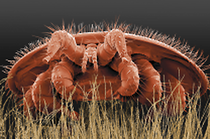

Through the ages, mites and parasites have been attacking bee colonies, but what is happening now to such a terrible extent has several causes. One of the culprits may be our modern forestry and agriculture, which make wild bees disappear, while the domesticated honey bees have rapidly been forced to change both their nature and habits due to planned reproduction and genetic manipulation.
There are also a number of pesticides destroying the bees´ health and communication skills. Modern landscape alterations also affect the industrious little animals in a negative way. In a natural landscape a huge variety of plants bloom at different intervals during summer and thus the bees obtain a constant flow of essential nutrients. However, modern agricultural industry creates intense growth periods when food is abundant, though extensive weed control makes such periods followed by large gaps in the bees' food supply. When bees cannot meet their demand for a steady flow of food, imbalance occurs in the hive and they are forced to empty their stores of honey and nectar. In times of starvation it may even happen that bees are forced to eat their own fry, in order for their community to survive. Everything an individual bee will do is done for the public good and therefore a small change in the nature and behavior of a few single bees may affect the entire bee community, a society that during millions of years has evolved into a strictly organized unit. Everything, however, is now threatened by human impact that may lead to a lethal imbalances, characterized by utter chaos and confusion. The dramatist and Nobel Prize winner Maurice Maeterlinck writes in his beautiful and fascinating book Life of the Bee, from 1901:
The bee is above all, and even to a greater extent than the ant, a creature of the crowd. She can live only in the midst of a multitude. When she leaves the hive, which is so densely packed that she has to force her way with blows of her head through the living walls that enclose her, she departs from her proper element. She will dive for an instant into flower-filled space, as the swimmer will dive into the sea that is filled with pearls, but under pain of death it behoves her at regular intervals to return and breathe the crowd as the swimmer must return and breathe the air. Isolate her, and however abundant the food or favourable the temperature, she will expire in a few days not of hunger or cold, but of loneliness.
From the crowd, from the city, she derives an invisible aliment that is as necessary to her as honey. This craving will help to explain the spirit of the laws of the hive. For in them the individual is nothing, her existence conditional only, and herself, for one indifferent moment, a winged organ of the race. Her whole life is an entire sacrifice to the manifold, everlasting being whereof she forms part.

It was once believed that the queen bee - except for the drones all bees are of the female sex – governed all the other bees in the hive, but that is not the case. Even the queen must abide to what is best for the entire bee community. If, for example, bad weather and scarce food are pestering the hive, the worker bees hinder their queen from laying any more eggs, the food must suffice for each larvae growing in its cell. However, it cannot be denied that the queen is the heart of society, at the absolute center of the lives of bees. Maeterlinck writes:
For indeed the ascetic workers, her daughters, regard the queen above all as the organ of love, indispensable, certainly, and sacred, but in herself somewhat unconscious, and often of feeble mind. They treat her like a mother in her dotage. Their respect for her, their tenderness, is heroic and boundless. The purest honey, specially distilled and almost entirely assimilable, is reserved for her use alone.
She has an escort that watches over her by day and by night, that facilitates her maternal duties and gets ready the cells wherein the eggs shall be laid; she has loving attendants who pet and caress her, feed her and clean her, and even absorb her excrement. Should the least accident befall her the news will spread quickly from group to group, and the whole population will rush to and fro in loud lamentation. Seize her, imprison her, take her away from the hive at a time when the bees shall have no hope of filling her place.

Should disaster befall the little republic; should the hive or the comb collapse, should man prove ignorant, or brutal; should they suffer from famine, from cold or disease, and perish by thousands, it will still be almost invariably found that the queen will be safe and alive, beneath the corpses of her faithful daughters.
Through Maeterlinck's portrayal, we understand that bees can communicate with each other. They actually have a very complicated language. On the bee's head we find angular curved feelers, it is through them she sends messages to other bees, by touching them with her vibrating beams and also by emitting odor string bees are capable of keeping order within a society where thousands of sisters, each and every one with her allotted task, find different means to coexist within the hive.
The great bee authority and Nobel laureate Karl von Frisch succeeded after years of patient research to crack the code of the bees' dance. If a scout bee finds a host of nectar-filled flowers she hurries home to tell her hive´s inhabitants about her discovery. She does so by placing herself on a vertical honeycomb and surrounded by her sisters she dances to show them where the flowers are.


If the flowers grow less than eighty meters from the hive the scout bee performs a circling dance, first to the left and then to the right, while she emits a scent that tells the bees that have gathered around her how the flowers she has spotted smell. Are the flowers further away than eighty metres, the scout bee performs a kind of waggle dance. The direction and duration of the waggle movements are correlated to the direction and distance of the flowers advertised by the dancing bee. The direction to the flowers is indicated with the sun as a benchmark. The bee positions her body in relation to the sun's location in the sky and like a hand on a clock she moves her body in such a way that surrounding forage bees understand in what direction and how far they must fly to find the flowers.
Honey bees are bred by humans to be docile, highly productive, as well as faithful to their communities and hives. In a far too limited extent, they have been conceived with a view to strengthen their resistance to diseases. Unlike bees, humans are selfish individuals and while breeding honey bees we concentrated on our own benefit, not on the fact that the coveted honey bees must also feel good and be healthy. Genetic variation within and among domestic bee colonies is very small and has in the past century shrunk further. However, it was disease attacks on the colonies that triggered the 1900s very extensive breeding of domesticated honey bees.
In 1910 a German, very devoted Catholic woman sent her twelve-year-old son to a monastery in England. Her decision was based on a desire to establish Catholicism in England and as a poor mother she also wanted to secure her son's future. In a Catholic newspaper, she had read that English Benedictine monks worked on restoring a cloister torn down during the English Reformation.
The homesick and timid Karl Kehrle proved to be too weak for the heavy construction work and was instead engaged with the monastery´s beehives. His devotion and extraordinary skills convinced the monastery's abbot to appoint him Master Bee Keeper in 1921. The main reason for the bashful Kehrle´s distinction was that when the abbey´s bees were dying from a mysterious viral illness he paired his queen bees with yellow drones he had received from an Italian monastery. The new bee variant resulting from the coupling of English and Italian bees proved to be resistant to the deadly viral infection and with the abbey's blessing Karl Kehrle, now called Brother Adam, began to write to monasteries around the world and ask them to send drones and queens.
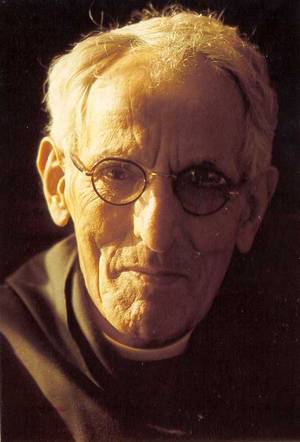
Brother Adam also got permission to visit different places around the world in search of bees and thus ended up in remote, exotic locations in both Africa and Asia, where he found bees which could promote his quest to create the perfect bee. Through great patience and a gentle touch, it was a painstaking process to inseminate queen bees, Brother Adam succeeded in creating a bee breed he named after his abbey, The Buckfast Bee. It was a strong and sturdy bee, which produced abundant amounts of honey and only in case of emergency used her poison sting. The bee turned out to be a success among beekeepers all over the world and the cloister became a renown quality brand, like the monastery of Fécamp in Normandy which became rich by producing the famous Benedictine liquor. Just like the tasty alcohol brought benefits to the French brethren, the Buckfast Abbey obtained a considerable income from Brother Adam's bee:
Like the British themselves it is a mongrel combining the virtues of the native bee with those of worthy bee from elsewhere.

Wherever in the world apiarists meet they now talk with reverence of Brother Adam's amazing bi and his fellow friars stated that:
He was unsurpassed as a breeder of bees. He talked to them, stroked them. He brought to the hives a calmness that, according to those who was him at work, the sensitive bees responded to. He was very upset when two of the abbey´s queen bees were stolen, and remarked on the frailty of humans. Bees, he said would never behave like people.
The brethren could, maybe somewhat mischievous, comment on Brother Adam´s manners:
He loved the bees almost as much as he loved God.
In 1991, the dreaded vaora mite made its appearance in Brother Adam's hives and he asked the abbot if he could be assigned a research assistant who could help him to breed a variant which was resistant to the deadly virus spread by the mite, but despite his abbey had become world famous and benefitted from the work of Brother Adam's work, the abbot rejected the now over ninety-year-old monk's request. When he was reached by the angry protests of beekeepers all over the world the abbot responded wryly: "I am sure that he would consider himself a monk first and a beekeeper second." Seven years later Brother Adam died, without having returned to beekeeping.
Perhaps people like the gentle Brother Adam are partly to be blamed for the horrible Colony Collapse Disorder. Through his manipulations of God's creation the good monk has been part of destabilizing the nature of divine harmony. As pointed out by Maeterlinck, a hive is a wonder of thorough order and discipline. Every single detail of the body functions and activities of a single honey bee is strictly governed by the welfare of an entire.
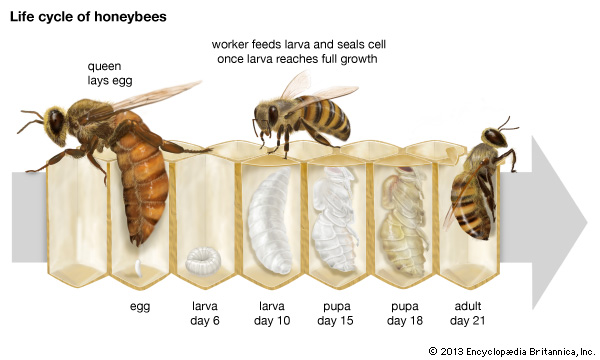
A worker bee is born when a chrysalis use its jaws to chew through the cocoon covering her within a perfectly shaped cell and then break through its vax seal. As soon as it has left her own cell the little bee starts to clean other emptied cells so they can receive nectar, honey and the eggs of the bee queen.
Bees are exceptionally clean animals. They stamp their feet if they want to be cleaned and the new born cleaning bees gather around them. With their largely unexplored language they notify the cleaners which parts of their bodies they want to be freed from dirt and parasites.
After some weeks, some bees have developed their venom glands and start patrolling the hive entrance to protect their sisters from attacks from other bees and parasites. Other bees have at the same time by an abundant pollen intake developed honey-producing organs used to provide food for the larvae, which live in amazing hexagonal cells constructed with the help of wax, formed under worker bees' abdomen. They mold and shape the wax with their feet and mouths. The cells are perfectly angled to hinder honey and nectar from running out of them, furthermore they are designed in such a way that they make a maximum use of the hive´s limited space, something architects throughout the ages have observed, marveled at and imitated.
So was, as an example, he eccentric pacifist and architect Richard Buckminster Fuller inspired by bees´ cells to construct his "geodesic domes", which now are used to construct radar stations, exhibition halls, greenhouses and more. These lightweight and stable structures consist of bars surrounding plates made of glass or other transparent materials, shaped like the cells of bee hives.


Twelve days old, the worker bee receives nectar and pollen from older forager bees and then packs the food in specially constructed cells. Forager bees arrive in a steady stream to the hive where they are welcomed by worker bees, who devour the nectar brought in by the foragers. The workers store nectar inside their “honey stomach”. The act of transferring nectar from one bee to another gave Medieval observers the impression that worker bees welcomed the foragers with a kiss.

The workers then spits out the nectar, which inside their bodies has been turned into honey, into specially prepared cells. Now, other bees are arriving their task is to make water evaporate so the honey thickens. They do this by flapping their wings. When the process is completed and the honey has thickened the storage cells are sealed with wax.
Constant fanning fills an important task within the hive and is crucial for its survival. The large amount of individuals continuously emits heat. For the larvae to develop it is required that the hive keeps a temperature between 32 and 36 degrees. This means that in addition to the fanning bees working inside the hive, a group of them also has to place themselves at the entrance. There they stand with their heads facing the hive and incessantly flap their wings in order to suck air from the hive and make cooling air circulate among their thousands of sisters who are operating inside its darkness.

There are also bees which unceasingly collects water and spread it over the cells; when the water evaporates it cools the cells, stimulating a regular growth of the larvae. If the ambient temperature rises alarmingly some worker bees interrupt their work and hurry to unite themselves with the with fanning group working by the hive entrance, flapping their wings until the temperature drops in the hive. It is the fanning bees' wings that create the mild humming noise surrounding a bee hive.
After a few weeks, the bees have evolved so much that they can become foragers and head out of the hive to collect the nectar. A forager bee may in one day visit more than ten thousand flowers, which through their visit become fertilized and thus will benefit countless beings, including humans. A common forager bee does not live longer than five weeks and during her lifespan she collects nectar enough to fill a teaspoon of honey. During that time other bees are busy producing honey, building new cells, cleanings the old ones and attending the larvae. As summer draws to a close the hive is being prepared for winter. First the drones are killed and then the worker bees are dying from starvation and exhaustion until five thousand bees remain of the hive´s population, which during the summer months is approximately 50,000 inhabitants. The survivors gather around their queen to keep her warm during winter. A queen lives for up to three years.
The only ones who do not work diligently in the hive are its male inhabitants - the drones. They are bulkier built and have larger eyes than the female bees and they have a humming sound; their only function is to fertilize queens. One day, shortly after the hive has come to life, the queen leaves it. Before bidding farewell she lays a number of unfertilized eggs which will give rise to drones, male bees thus originate from a form of parthenogeneisis, virgin birth. The queen leaves the hive on her own and flies away to meet with drones from another hive, these are waiting while their large eyes scan the sky on the lookout for a willing female. When such a bee flies by, the drones take flight and swarm around her, mating with her up in the air. Up to thirty drones can mate with a queen bee, before she returns home and begins to lay eggs in the prepared cells.
The drones have no sting and are fairly helpless creatures. When autumn arrives the drones are forced out of the hive. They are now seven weeks of age; inept, old and infirm they quickly starve to death in their solitude.
Bee colonies have through the millennia been regarded with awe. Their strange, strict organization and the individual bee´s immense diligence when it comes to the public good, have been compared to human societies, often to the benefit of the bee. However, what is the single bee´s reward for working herself to death for her community? Apart from their winter hibernating, bees never sleep, except for brief seconds of rest, especially at midday. Those who have been praising the bees' life have been either despots and capitalists who for their slaves and workers have preached the happiness involved in hard work, or socialist utopians who have been fascinated by what Maeterlinck described as a "sacrifice of privacy for a constant hardship suffered for the general good."


Of the thirteen people in the inner circle who prepared the October 1917 revolution in Russia, ten fell victims to the Soviet Government they had created. Only Lenin, Stalin and Alexandra Kollontai died a natural death. The latter wrote in 1923 a collection of short stories called Love of Worker Bees. In Sweden, it became popular in the early eighties. I read it and became somewhat irritated, while my feminist, female friends loved it. When I stated that I found the book confusing and that the stories droned on redundantly, they became angry with me. I defended myself by saying that perhaps it was because the book was written during a time that was not identical to ours. Nevertheless, they considered it to be crystal clear and told me that my chauvinistic opinions originated from the fact that I was a man and accordingly was unable to understand women´s writing. I tried to amend by admitting that Kollontai could have good reason for writing:
Perhaps women ought to be brought up not to give so much in love and men to give more. A man has to learn to become a mirror and a resonance for the woman he loves.
Of course we all, men and women alike, ought be brought up to give love, but it must of course be a mutual give and take. I have several male friends who have given more in their love, than the women they cared for.
What angered me most about Kollontai´s writing was that she, in my opinion, forgot about children´s need of love and family. She considered marriage and families as legacies of an oppressive, capitalist, property-rights-based and egoist past. Under Communism, women and men would work for a just society of their own creation. A society that would care for its members and support them. Not a society where each family functioned as a self-sufficient little cell, working only for the benefit of itself, or worse the patriarch who controlled it.
In H. G. Wells amazing novel The First Men in the Moon, two men secretly arrive on the moon in a spacecraft of their own design. Inside the moon they encounter The Selenites, who exist in thousands of forms and find fulfillment in carrying out specific social functions for which they have been brought up. Specialization is the essence of Selenite society. “With knowledge the Selenites grew and changed; mankind stored their knowledge about them and remained brutes” remarks their ruler, the Grand Lunar, when he has learned English and is told about human life. The Selenites are "stricken with amazement" when they learn about humanity's propensity for war and in an effort of self-preservation their rulers try to avoid Earthlings from knowing anything about them and their civilization, which is far more advanced and especially more harmonious and peaceful than the one of the humans.
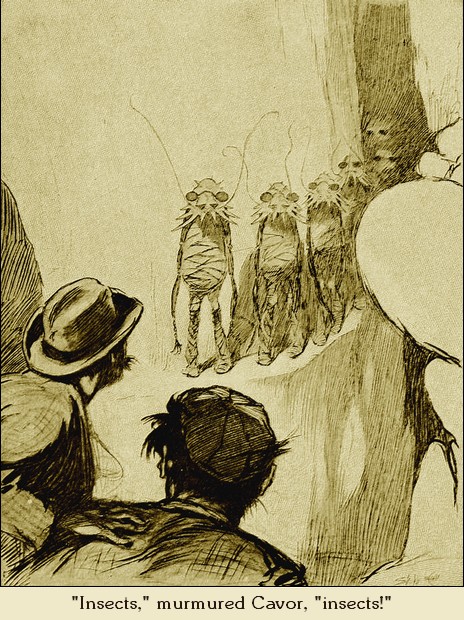

Wells´ visionary description of Selenite society seems to predict views proposed by sociobiologists like E.O. Wilson, who have proposed that human society is evolving in a manner similar to those of eusocial species (eu is Greek standing for “good/real"), like bees and ants. This way of thinking that emphasizes the importance of group thinking and altruism is an important and benevolent factor for evolution. Wilson writes about biophilia, meaning “love of life, or living systems”. For a sociobiologist like Wilson, the hive is like a sophisticated super organism functioning like some kind of communal brain, benefitting the welfare of an entire community.
Other scientists and ideologists have gone even further and envisioned a future where megacities function like some kind of bee hives, where computer networks have become a mighty artificial intelligence, which independently of human intervention governs society in a benevolent manner, similar to the sophisticated exchange of rules and communication within a bee hive, where every individual in a subconscious manner work for the common good. In such a society, individual sexual desire and family life are becoming obsolete as part of an evolutionary process that does not encourage creatures to put family first, a behavior which according to eusocialists has been the main reason to humans´ success.
We are thus back to Alexandra Kollotrai´s view that Children would be wards of society, and reared by it:
The worker-mother must learn not to differentiate between yours and mine; she must remember that there are only our children, the children of Russia's communist workers
Undeniably a picture as good as any of the bee´s loveless world.
But how come that this little insect has become so intimately related to love and the good life? Both the Roman god of love, Cupid and his Hindu counterpart, Kama, are depicted and connected with bees.


Perhaps the human admiration of the honeybee is not just based on its sense of organization and hard work for the common good – ants are just as laborious. But for what? What do those little industrious insects give us humans, more than problems? How different are the bees! They give us the good things in life. It is enough to imagine how boring life during the Viking Age´s cold winter nights must have been up here in the gloomy north. Without access to the lovely goods we human are stealing from the bees. In those winter days back then there were no other sweets than dried fruit and honey. The darkness was lit by scented candles made of beeswax, in whose glow the Vikings could enjoy their intoxicating honey wine, the mead, the preferred drink of their gods. Sugar and distilled beverages did not appear until the sixteenth century. With such beautiful gifts, it was perhaps not surprising that bees and honey became connected not only with summer and flowers, but also with love and the good and healthy life.

You call your loved one “honey” and Indo-European languages are filled with allusions to honey and love. Kisses are like honey, praise are like honey to our ears, youthful skin is honeyed, rich countries flow with milk and honey. The list of words and concepts connecting honey and bees to love and well-being seems to be endless. And when the industrious little insect now is threatened with extinction, we humans have every reason to grieve. The bees are part of our culture, for better or worse - we depend on each other.
Wivallus´ poetical description of a cold spring and the beautiful, Swedish summer brought me to the bees. Now I am back again in Hässleholm. As I sit in my room and write this blog post, I suddenly remember that one of my daughters on Mother's Day placed a picture of me and my mother on Facebook. It was a photograph taken of the two of us in a summer meadow, sometime in the fifties. When I now look it, I cannot help but make a farfetched connection to my own existence, love and bees' lives.

The author Maurice Maeterlinck, famous for his static but evocative symbolist love dramas, was throughout his life an enthusiastic beekeeper. Maeterlinck's beautiful book, La vie des Abeilles, Life of the Bee, was an inspiration for this blog post. A few years earlier, Maeterlinck wrote the book Le Trésor des humbles, The Treasure of the. I find it hard to take to me this kind of "spiritual" literature. A tradition where we find trendsetting bestselling authors like Kahlil Gibran and Paulo Coehlo, in my opinion both equally morose. Somewhat platitudinous writings, which in a poetic and beautiful language want the reader to connect with her/his inner spiritual life. Despite my reluctance, I have made repeated attempts to read The Treasure of the Humble, and the cause is my father and mother.
In1948, my father who then was thirty-one years of age was working as a journalist at the now long-defunct Eksjö News. On the streets of Eksjö he occasionally glimpsed a beautiful, blond and slightly ethereal nurse. He began to discreetly search for her and inquired among his acquaintances if any of them knew anything about her. She seemed to be shy and taciturn. He therefore did not know in what manner he could approach her. Sometimes she ordered a cup of warm chocolate and whipped cream on one of the city's patisseries, but she never appeared on any dance at the City Hotel, or anywhere else where Axel could make contact with her. However, from time to time she visited the City Library and Axel Lundius assumed that if his friend the librarian could tell him something about the beautiful girl´s reading habits, he could perhaps accidentally look her up at the cafe and strike up a conversation about common literary interests.

The librarian smiled at Axel's request:
- Well then, it's a remarkable young lady. Sometime ago she came with an unusual request. She wanted to order a book by Maurice Maeterlinck.
- Maurice Maeterlinck! Who on earth read such stuff nowadays?
- Yes, I was wondering the same. Anyhow, I ordered the book for her. She recently returned it. Here it is. Do you want to borrow it?
- Of course, replied my father, amazed and curious, and took the book home.
It was Le Tresor des humbles in the original language, but only the first few pages were ripped open. It turned out that my mother thought the French too difficult and returned the book unread. It was one her aunts, a school teaahcer, who had recommended it. Anyway, the book proved to be helpful when Axel one evening saw the coveted nurse on one of the dances at the City Hotel. Inga Haking, that he now knew that the girl was called, had arrived in the company of a nursing friend. He gathered courage, introduced himself to the young ladies and his newly acquired knowledge of Maeterlinck was a good introduction to his attempts to make contact and as he already knew that Inga was interested in spiritual dimensions of life he also spoke about the Bible.
So Maeterlinck has had some influence on the fact that there is now a photo of me and mother together in a summer meadow.
Let the gates of heaven be opened wide,
Calm the storms, don´t make them violent.
Let the nightingale sing with force and pride,
him that the cold made silent!
Let sing the young
with unrestrained tongue.
Let children dance and forget they cried!

Frisch, Karl von (1970) Dancing Bees. London: Metheun & Co. Kollontai, Alexandra (1977) Love of Worker Bees. London: Virago. Maeterlinck, Maurice (2006) Life of the Bee. New York: Dover Publications. Maeterlinck, Maurice (2005) TheTreasure of the Humble. Whitefish Montana: Kessinger Publishing. Mann, Charles C. "Quest for a Superbee" in National Geographic, May. Wells, H.G. (2005) The First Men in the Moon. London: Penguin Classics. Wilson, E.O. (2012) The Social Conquest of Earth. New York: Liveright Publishing Corporation. Wilson, Bee (2004) The Hive: The Story of the Honeybee and Us. London: John Murray. Wroe, Ann and Keith Colquhoun (1996) "Obituary: Benedictine monk and beekeeper Karl Kehrle" in The Economist, September 14.






